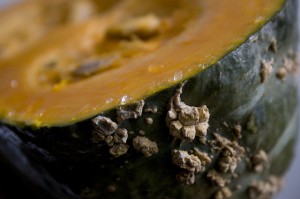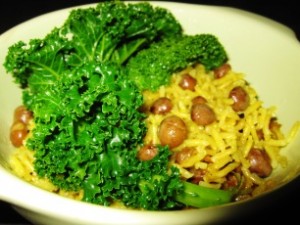I’d been perusing an old copy of Saveur in a waiting room at the doctor’s a while back and remembered seeing a recipe for a Taiwanese squash dish. This came to mind after finding a fresh kabocha at the farmers market the other week, and after some Googling,
I located their recipe for Chao Nan Gua. Intrigued yet again, I set to work.
Disorganized as usual, I didn’t actually have fresh ginger or white sugar on hand, and so I used what I had, and futzed with proportions both intentionally and by spilling some and making it up on the fly.
I used:
About 1.5 tbs. canola oil
1 1/2 tsp. ground ginger (not the powder kind, the kind from a
jar…fresh would be better)
2 tsp. brown sugar
A few pinches sea salt
1/2 tsp. yuzu kosho*
1 small kabocha, peeled and cubed
Just under 1/2 cup water with a splash of rice vinegar
I put the squash in the microwave for a couple minutes to soften it enough for my not-great knife to cut, and while it cooked I set out my mise-en-place. In the process I spilled the water twice, knocked over my jar of salt, and burned myself with spattering pre-heated oil. This before drinks, even! These steps I don’t recommend. I do recommend that when it’s softened a bit, you cut up the squash.
So, as you may have guessed, I had preheated the oil over a high flame, and when it was hot added the ginger and yuzu kosho to toast a bit, then the squash, which I tossed in the spiced hot oil.
Then I added the sugar and salt and tossed the squash around some more. After a few seconds to let a glaze form, I added the water-vinegar mix and covered the lot with a lid. On reduced heat, I let the mixture braise for about 10 minutes, stirring every now and again.
The result was bloody delicious: sweet, nutty, and spicy!
* A note on yuzu kosho: this is the best reason to visit your local Japanese market I can think of (besides MSG-enhanced mayo). A paste of yuzu (a citrus somewhere between lime and Meyer lemon) and chili, it is a fantastic condiment I now put on way too many things.
-MAW
[ad]



